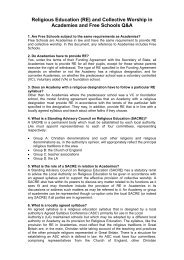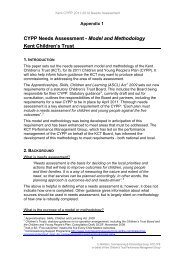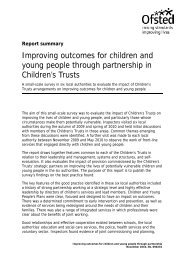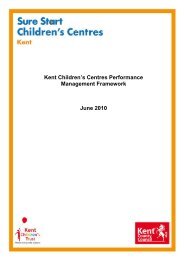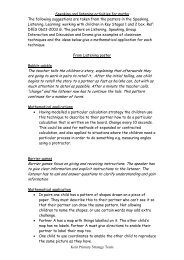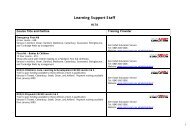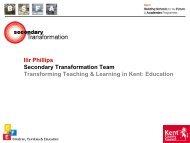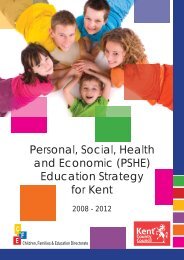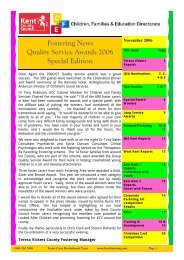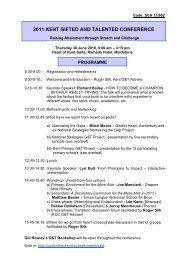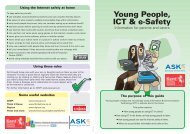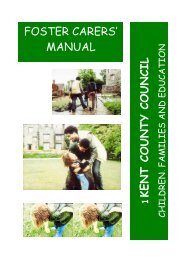Key Stage 1 - Kent Trust Web
Key Stage 1 - Kent Trust Web
Key Stage 1 - Kent Trust Web
Create successful ePaper yourself
Turn your PDF publications into a flip-book with our unique Google optimized e-Paper software.
Attainment target 3: Materials and their properties:<br />
Level 2<br />
Pupils identify a range of common materials and know about some of their properties. They describe<br />
similarities and differences between materials. They sort materials into groups and describe the basis for<br />
their groupings in everyday terms [for example, shininess, hardness, smoothness]. They describe ways<br />
in which some materials are changed by heating or cooling or by processes such as bending or<br />
stretching.<br />
Level 3<br />
Pupils use their knowledge and understanding of materials when they describe a variety of ways of<br />
sorting them into groups according to their properties. They explain simply why some materials are<br />
particularly suitable for specific purposes [for example, glass for windows, copper for electrical cables].<br />
They recognise that some changes [for example, the freezing of water] can be reversed and some [for<br />
example, the baking of clay] cannot, and they classify changes in this way.<br />
Level 4<br />
Pupils demonstrate knowledge and understanding of materials and their properties drawn from the <strong>Key</strong><br />
<strong>Stage</strong> 2 or <strong>Key</strong> <strong>Stage</strong> 3 programme of study. They describe differences between the properties of<br />
different materials and explain how these differences are used to classify substances [for example, as<br />
solids, liquids, gases at <strong>Key</strong> <strong>Stage</strong> 2, as acids, alkalis at <strong>Key</strong> <strong>Stage</strong> 3]. They describe some methods [for<br />
example, filtration, distillation] that are used to separate simple mixtures. They use scientific terms [for<br />
example, evaporation, condensation] to describe changes. They use knowledge about some reversible<br />
and irreversible changes to make simple predictions about whether other changes are reversible or not.<br />
Level 5<br />
Pupils demonstrate an increasing knowledge and understanding of materials and their properties drawn<br />
from the <strong>Key</strong> <strong>Stage</strong> 2 or <strong>Key</strong> <strong>Stage</strong> 3 programme of study. They describe some metallic properties [for<br />
example, good electrical conductivity] and use these properties to distinguish metals from other solids.<br />
They identify a range of contexts in which changes [for example, evaporation, condensation] take place.<br />
They use knowledge about how a specific mixture [for example, salt and water, sand and water] can be<br />
separated to suggest ways in which other similar mixtures might be separated.<br />
Level 6<br />
Pupils use knowledge and understanding of the nature and behaviour of materials drawn from the <strong>Key</strong><br />
<strong>Stage</strong> 3 programme of study to describe chemical and physical changes, and how new materials can be<br />
made. They recognise that matter is made up of particles, and describe differences between the<br />
arrangement and movement of particles in solids, liquids and gases. They identify and describe<br />
similarities between some chemical reactions [for example, the reactions of acids with metals, the<br />
reactions of a variety of substances with oxygen]. They use word equations to summarise simple<br />
reactions. They relate changes of state to energy transfers in a range of contexts [for example, the<br />
formation of igneous rocks].<br />
Attainment target 4: Physical processes:<br />
Level 2<br />
Pupils know about a range of physical phenomena and recognise and describe similarities and<br />
differences associated with them. They compare the way in which devices [for example, bulbs] work in<br />
different electrical circuits. They compare the brightness or colour of lights, and the loudness or pitch of<br />
sounds. They compare the movement of different objects in terms of speed or direction.<br />
Level 3<br />
Pupils use their knowledge and understanding of physical phenomena to link cause and effect in simple<br />
explanations [for example, a bulb failing to light because of a break in an electrical circuit, the direction<br />
or speed of movement of an object changing because of a push or a pull]. They begin to make simple<br />
generalisations about physical phenomena [for example, explaining that sounds they hear become<br />
fainter the further they are from the source].<br />
39



